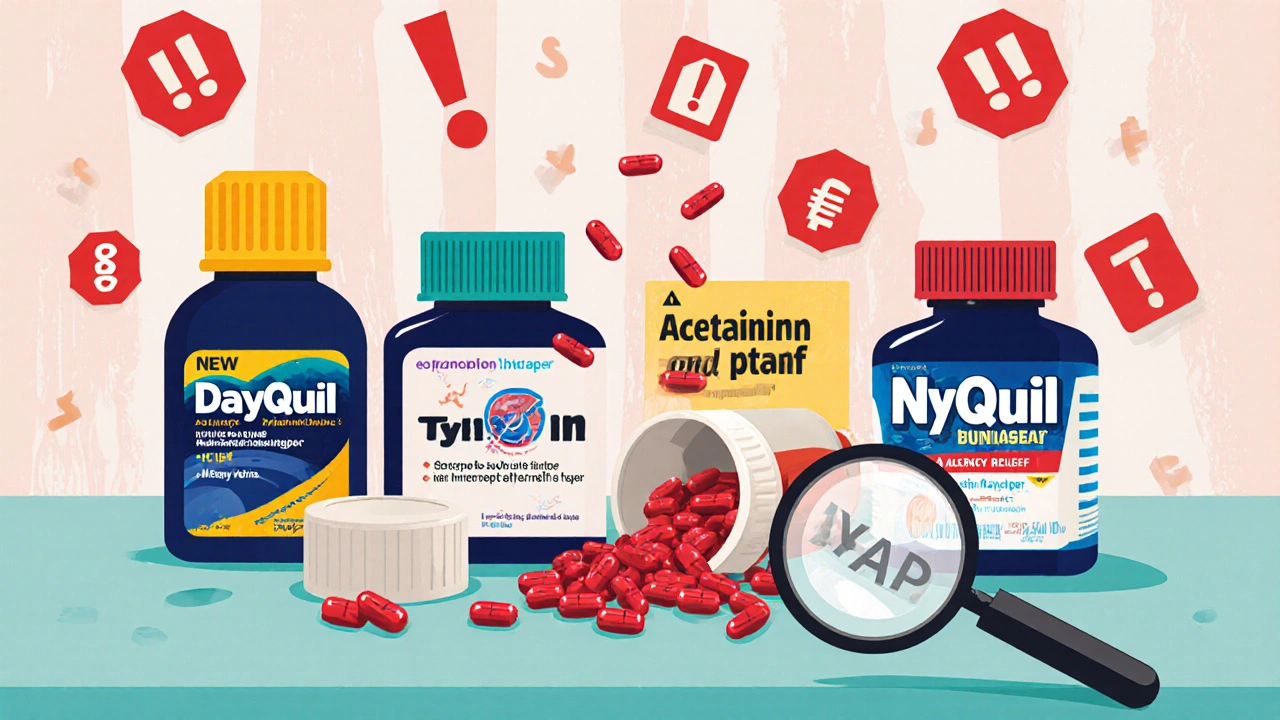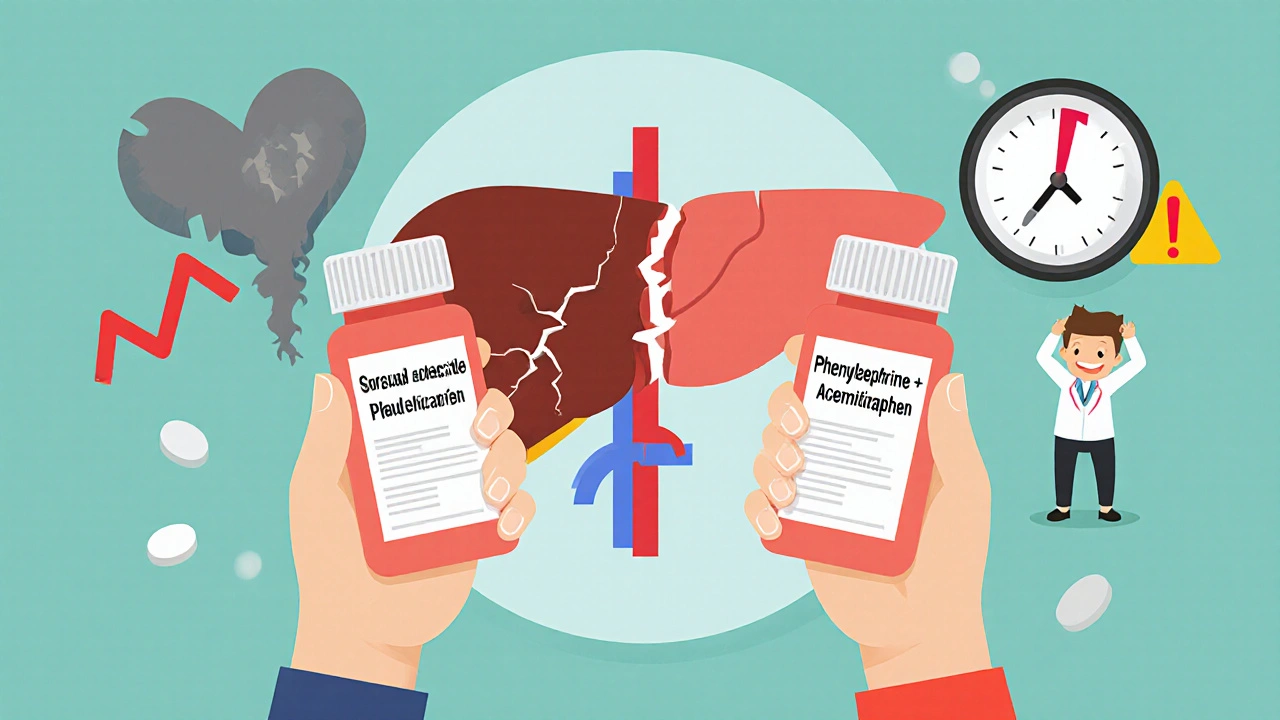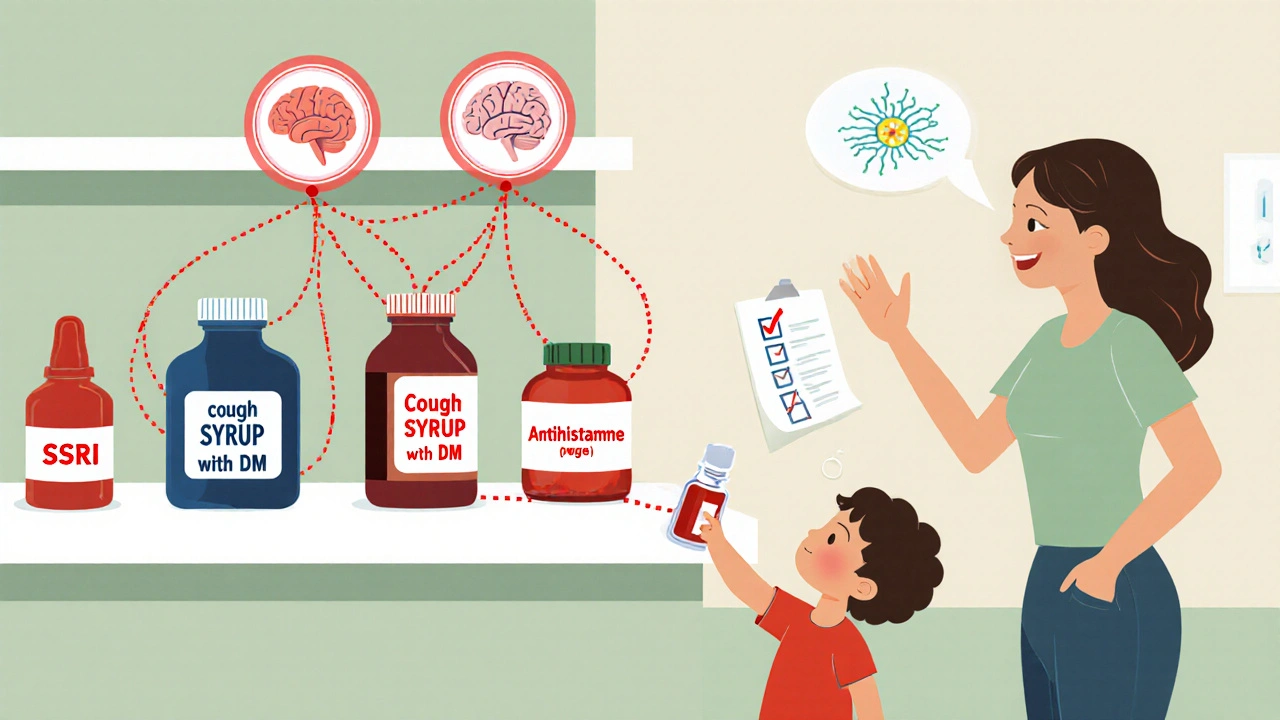Allergy and Cold Medications: How to Avoid Dangerous Interactions
 Nov, 16 2025
Nov, 16 2025
Medication Interaction Checker
This tool helps you check if your medications contain dangerous ingredient combinations or exceed safe dosage limits. Enter your medications below to identify risks.
Every year, millions of people reach for a bottle of cold or allergy medicine without reading the label. They see "multi-symptom relief" on the front and assume it’s safe-especially if they’ve used it before. But mixing these meds can land you in the ER. You might not realize you’re doubling up on acetaminophen. Or that the decongestant you took for a stuffy nose is raising your blood pressure dangerously high. This isn’t rare. It happens every day.
What’s Actually in Your Cold Medicine?
Most over-the-counter cold and allergy meds aren’t just one drug. They’re cocktails. A single pill or liquid might contain four different active ingredients, each targeting a different symptom. You’ve probably seen them: acetaminophen for fever and pain, pseudoephedrine or phenylephrine to unblock your nose, dextromethorphan to quiet your cough, and chlorpheniramine or diphenhydramine to stop the runny nose and itchy eyes. These combinations were designed for convenience. But convenience comes at a cost. The FDA says about 6.7 million Americans accidentally take too much acetaminophen every year-mostly because they didn’t realize their cold medicine already had it. And that’s just one ingredient. When you add in decongestants, cough suppressants, and antihistamines, the risks multiply.The Hidden Danger: Acetaminophen Overdose
Acetaminophen is the most common ingredient in these combo pills. It’s in Tylenol, DayQuil, NyQuil, TheraFlu, and dozens of others. The maximum safe daily dose is 4,000 milligrams. But if you take one pill with 500mg, then another with 325mg, then a separate pain reliever with 500mg-you’re already at 1,325mg. Do that three times a day? You’re over 4,000mg. And you might not even know it. The problem? Acetaminophen overdose doesn’t hurt right away. No stomach pain. No dizziness. Just silent liver damage. By the time you feel sick, it’s often too late. In 2021, the FDA issued a safety alert specifically warning about this. They said combination cold meds are responsible for the majority of accidental overdoses. And it’s not just pills-liquid forms can be just as dangerous, especially if you’re giving them to kids or mixing them with other medicines.Decongestants: Phenylephrine vs. Pseudoephedrine
Not all decongestants are created equal. You’ll find two main ones: phenylephrine and pseudoephedrine. Pseudoephedrine (found in Sudafed) is proven to work. It shrinks swollen blood vessels in your nose, letting you breathe. But it also raises your blood pressure and heart rate. If you have high blood pressure, heart disease, or an overactive thyroid, this can be dangerous. Phenylephrine is cheaper and easier to stock on shelves. But here’s the catch: research shows oral phenylephrine, at standard doses (10mg), doesn’t work much better than a placebo. A 2022 study from the University of Florida and Rutgers found that across 11 clinical trials, phenylephrine had no significant decongestant effect. Yet it’s still in almost every major brand-Tylenol Sinus, Mucinex D, Robitussin Peak Cold. Worse, when phenylephrine is combined with acetaminophen, your body absorbs more of it. A 2014 study in the Journal of Clinical Pharmacology showed phenylephrine blood levels jumped to four times higher when taken with acetaminophen. That means more side effects: dizziness, rapid heartbeat, tremors, and dangerously high blood pressure. One New Zealand study found phenylephrine-acetaminophen combos caused 4.1 times more hypertension-related problems than acetaminophen alone.
Dextromethorphan and Antidepressants: A Silent Risk
Dextromethorphan (often labeled as "DM") is in most cough syrups and cold pills. It’s fine if you’re healthy. But if you’re taking an SSRI like sertraline (Zoloft), fluoxetine (Prozac), or an SNRI like venlafaxine (Effexor), you’re playing with fire. Dextromethorphan affects serotonin levels in the brain. So do SSRIs and SNRIs. When you combine them, serotonin can build up to toxic levels. This is called serotonin syndrome. Symptoms? Agitation, confusion, rapid heart rate, high blood pressure, muscle rigidity, fever, and seizures. It can be fatal. A 2017 study in the Journal of Clinical Psychiatry found that people taking dextromethorphan with SSRIs had a 300% higher risk of serotonin syndrome. That’s not a small chance. It’s a red flag. If you’re on antidepressants, avoid any cough medicine with dextromethorphan. Look for alternatives like guaifenesin (an expectorant) or plain honey for cough relief.Why Label Reading Isn’t Enough
You might think, "I read the label." But most people don’t know what the abbreviations mean. "APAP"? That’s acetaminophen. "PE"? Phenylephrine. "DM"? Dextromethorphan. "CB"? Chlorpheniramine. If you don’t know these, you’re guessing. A University of Arizona study found that 68% of people didn’t recognize "APAP" as acetaminophen. That means two out of three people could be doubling up without realizing it. Labels are getting better-the FDA now requires high-contrast ingredient lists and bold warnings about duplicates-but the system still fails too often. And then there’s the problem of multiple bottles. You take one cold medicine for your cough, another for your allergies, and a third for your headache. Each has its own mix. You think they’re different. They’re not. They might all have the same active ingredients.What You Should Do Instead
Stop reaching for the multi-symptom bottle unless you actually have multiple symptoms. If you only have a runny nose? Take an antihistamine alone. Only a headache? Take plain acetaminophen or ibuprofen. Only a cough? Try a single-ingredient dextromethorphan-free option like honey or guaifenesin. If you must use a combo product:- Read every ingredient. Write them down.
- Compare them to any other medicine you’re taking-including vitamins and supplements.
- Check for duplicates. If two products have the same active ingredient, don’t take them together.
- Never exceed the daily limit for acetaminophen (4,000mg), even if you’re not feeling better.
- If you’re on antidepressants, avoid dextromethorphan completely.
- If you have high blood pressure, avoid pseudoephedrine and phenylephrine.

mike tallent
November 16, 2025 AT 16:37Just took a look at my medicine cabinet and holy crap I’ve got 3 bottles with acetaminophen in them. 🤯 Time to toss the extras and go single-ingredient from now on. Thanks for the wake-up call - this is the kind of info you wish you knew before your liver starts screaming.
Peter Stephen .O
November 17, 2025 AT 21:59Y’all need to stop treating OTC meds like candy. I’ve seen grandmas take NyQuil + Tylenol + Zyrtec + Advil and wonder why they’re dizzy and sweating. It’s not magic - it’s chemistry. Read the damn label. Use the Medisafe app. Your body isn’t a lab experiment. Be smart, not lucky.
jalyssa chea
November 18, 2025 AT 05:07why do people even buy these combo pills anyway i mean its not like your gonna die from a runny nose or a cough but then again i guess some folks just wanna feel better fast and dont care if they fry their liver i mean its just a cold right
Joyce Genon
November 19, 2025 AT 17:41Let’s be real - this isn’t about ignorance. This is about corporate greed. They put phenylephrine in everything because it’s cheap and they can slap a ‘clinically proven’ sticker on it even though it’s basically sugar water. And they know people won’t read the label because most Americans can’t read past the word ‘relief.’ The FDA’s new rules? Too little, too late. They’ll just rename it ‘New & Improved’ and keep selling the same poison.
Gary Lam
November 21, 2025 AT 11:41So let me get this straight - we’re supposed to trust a pharmacist over a $5 bottle of medicine that says ‘48-HOUR RELIEF’ in neon letters? I mean, I love my local CVS guy but he’s also the same guy who sold me ‘immune booster’ gummies with 3g of sugar and zero vitamins. 🤷♂️
Andrew Cairney
November 22, 2025 AT 17:28They’re hiding the truth. The FDA knows phenylephrine doesn’t work. The studies prove it. But Big Pharma owns the regulators. You think they’re gonna pull 20 billion dollars in sales just because a couple of scientists said ‘nah’? Wake up. This is why you see ‘NEW FORMULA’ on the bottle every 6 months - it’s not an upgrade, it’s a distraction. And don’t even get me started on the ‘natural’ cough syrups with hidden dextromethorphan…
Rob Goldstein
November 23, 2025 AT 15:42As a clinical pharmacist, I see this daily. The most common interaction I flag? Dextromethorphan + SSRIs. Patients say, ‘But I only took one cough drop!’ - and then they show me a bottle with 30mg of DM. That’s enough to trigger serotonin syndrome in someone on fluoxetine. We need better labeling, yes - but we also need better patient education. Ask your pharmacist. Seriously. We don’t bite.
Abdul Mubeen
November 25, 2025 AT 02:45This article is dangerously misleading. The real issue is not the medication - it’s the decline of personal responsibility. If you can’t read a label, why are you allowed to drive? Why are you allowed to use a microwave? Why are you allowed to have children? This isn’t a public health crisis - it’s a failure of basic literacy. The solution isn’t more regulation. It’s fewer people buying medicine.
vinod mali
November 25, 2025 AT 16:57in india we just use tulsi leaves and ginger tea for cold and cough no pills needed really. sometimes simple is better. but i know its hard for people used to quick fixes
Kathy Grant
November 26, 2025 AT 14:19I used to think ‘multi-symptom’ meant efficiency. Now I see it as a trap wrapped in a rainbow sticker. I remember taking NyQuil and Zyrtec together after a long week - woke up at 3 a.m. with my heart pounding like a jackhammer, convinced I was having a stroke. Turned out it was just the phenylephrine + diphenhydramine combo. I cried. Not from pain - from shame. Why didn’t I know? Why didn’t anyone tell me? We’re taught to ‘take care of ourselves’ - but no one teaches us how to read a bottle.
Jennie Zhu
November 26, 2025 AT 17:59It is imperative to underscore that the pharmacokinetic interactions between acetaminophen and phenylephrine, as elucidated in the 2014 Journal of Clinical Pharmacology study, demonstrate a statistically significant increase in plasma concentration of phenylephrine, thereby amplifying adrenergic receptor activation and potential cardiovascular sequelae. This is not merely anecdotal; it is a well-documented pharmacodynamic synergy requiring clinical vigilance.
Robert Merril
November 26, 2025 AT 19:47lol i took 3 cold meds last week and im still alive so maybe its not that bad? also who cares if phenylephrine dont work its just a pill not a bomb
John Wayne
November 28, 2025 AT 00:38How quaint. You assume the average person reads labels. I’ve seen the packaging. It’s designed to be confusing. The font size of the active ingredients is smaller than the marketing claims. The abbreviations are deliberately obscure. This isn’t negligence - it’s intentional obfuscation. And you’re the fool if you think the FDA’s new rules will change that. They’re written by lobbyists with a 10-year-old’s vocabulary.